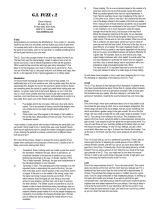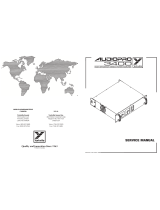Page is loading ...

Fuzz Face (BASIC)
No mess, no fuss...
just fuzz
Contents of this document are ©2021 Pedal Parts Ltd.
No reproduction permitted without the express written
permission of Pedal Parts Ltd. All rights reserved.

Important notes
If you’re using any of our footswitch daughterboards,
DOWNLOAD THE DAUGHTERBOARD DOCUMENT
•Download and read the appropriate build document for the daughterboard
as well as this one BEFORE you start.
•DONOT solder the supplied Current Limiting Resistor (CLR) to the main
circuit board even if there is a place for it. This should be soldered to the
footswitch daughterboard.
POWER SUPPLY
Unless otherwise stated in this document this circuit is designed to be
powered with 9V DC.
COMPONENT SPECS
Unless otherwise stated in this document:
•Resistors should be 0.25W. You can use those with higher ratings but
check the physical size of them.
•Electrolytics caps should be at least 25V for 9V circuits, 35V for 18V
circuits. Again, check physical size if using higher ratings.
LAYOUT CONVENTIONS
Unless otherwise stated in this document, the following are used:
•Electrolytic capacitors:
Long leg (anode) to square pad.
•Diodes/LEDs:
Striped leg (cathode) to square pad. Short leg to square pad for LEDs.
•ICs:
Square pad indicates pin 1.

Schematic - PNP (posi ground) Ge
R3 33K
R4 100K
R7 470R (1K)
BIAS 47K trim
C1 10n
C2 2u2 elec
C3 Empty
C4 Empty
C5 22u elec
Q1
Q2
FUZZ 1KB (2KB)
VOL 500KA
PNP Germanium <>70hFE
PNP Germanium <>120hFE
This is the original Fuzz Face design, along with a couple of value swaps (brackets)
for the Mayer modified version which is a bit louder and has a better range on the
Fuzz control.
This requires positive ground wiring, so can’t be daisy chained with standard
polarity effects unless you use a voltage inverter.
The parts on the PCB are laid out for this version.
Example transistors: AC128, 2N404

Schematic - NPN (standard ground) Ge
R3 33K
R4 100K
R7 470R (1K)
BIAS 47K trim
C1 10n
C2 2u2 elec*
C3 Empty
C4 Empty
C5 22u elec*
Q1
Q2
FUZZ 1KB (2KB)
VOL 500KA
NPN Germanium <>70hFE
NPN Germanium <>120hFE
A more pedalboard friendly version, along with a couple of value swaps (brackets)
for the Mayer modified version which is a bit louder and has a better range on the
Fuzz control.
This requires standard negative ground, so can be daisy chained with no issues.
*You must reverse C2 and C5 for this build, i.e. positive leg into round pad.
Example transistors: AC176, CV7351

Schematic - NPN (standard ground) Si
R3 33K
R4 100K
R7 470R (1K)
BIAS 47K trim
C1 10n
C2 2u2 elec*
C3 47-470pf**
C4 47-470pf**
C5 22u elec*
Q1
Q2
FUZZ 1KB (2KB)
VOL 500KA
NPN Silicon
NPN Silicon
Silicon version, along with a couple of value swaps (brackets) for the Mayer
modified version which is a bit louder and has a better range on the Fuzz control.
This requires standard negative ground, so can be daisy chained with no issues.
Any low-medium gain BJTs can be experimented with. BC108 and 2N2222 are
FDHQ favourites.
*You must reverse C2 and C5 for this build, i.e. positive leg into round pad.
**C3-C4 remove some high frequency from each gain stage in the form of negative
feedback. The higher the value, the more noticeable it’ll be as lower frequencies
are added to the range.

The power and signal pads on the PCB conform
to the FuzzDog Direct Connection format, so can
be paired with the appropriate daughterboard for
quick and easy offboard wiring. Check the
separate daughterboard document for details.
Be very careful when soldering the transistor.
They’re very sensitive to heat. You should use
some kind of heat sink (crocodile clip or reverse
action tweezers) on each leg as you solder them.
Keep exposure to heat to a minimum (under 2
seconds).
Snap the small metal tag off the pots so they can
be mounted flush in the box.
You should solder all other board-mounted
components before you solder the pots. Once
they’re in place you’ll have no access to much of
the board. Make sure your pots all line up nicely.
The best way to do that is to solder
a single pin of each pot in place then melt and
adjust if necessary before soldering in the other
two pins. If your pots don’t have protective
plastic jackets ensure you leave a decent gap
between the pot body and the PCB otherwise
you risk shorting out the circuit.
BIAS TRIMMER
You’ll notice there are six pads on the board for
the trimmer, but you only have three legs. The
extras are to allow different formats to be used.
The pads are connected within the PCB as
shown above in red. You need one leg in one pad
of each of the connected pairs.
TRANSISTOR PINOUTS
We’ve added an extra pad for each transistor to
make it easier to use cans without the standard
EBC pinout, like some Russians models.
So, for instance... a standard pinout germanium
2N404 or silicon BC108 would sit neatly within
the transistor outline shown on the silkscreen,
utilising the triangular formation of EBC.
This can be seen on the cover image.
A Russian GT308B has the pinout BCE, so would
mount into the holes in a diagonal line, like this:
PCB layout ©2021 Pedal Parts Ltd.
E
E
B
C

BIASING
Once everything’s soldered into place you need
to adjust the voltage going to the collector of Q2,
which sets the bias - the base voltage point from
which the transistor will operate. Setting this
correctly will give you the best balance of fuzz vs
gating. You should set this to around 4.5V, or half
your supply voltage.
To do this, set your multimeter to DC voltage
with the range (if not auto-ranging) to the
nearest voltage above 9 that is available,
normally 20V.
Place your Common probe on any ground point,
the most accessible being pin 1 of the Volume
pot marked in red above.
The + probe should go onto the collector of Q2.
If this isn’t easily accessible you can use the
empty pad, or the leg if you have a cap in there,
of C4 marked in blue.
The above applies to NPN circuits. If you’re
building PNP reverse the probes, or you can just
read the voltage as negative. It’s all good.
NUMBERS AREN’T
EVERYTHING...
Finding the correct bias by measuring is fine, but
you may find you prefer the voltage adjusted a
little one way or the other. Tweak by ear until
you’re happy. If you aren’t, just get the meter
back on and measure it again.

Test the board!
Check the relevant daughterboard document for more
info before you undertake this stage.
UNDER NO CIRCUMSTANCES will troubleshooting help
be offered if you have skipped this stage. No exceptions.
Once you’ve finished the circuit it makes sense to test is before starting on the switch and LED
wiring. It’ll cut down troubleshooting time in the long run. If the circuit works at this stage, but it
doesn’t once you wire up the switch - guess what? You’ve probably made a mistake with the switch.
Solder some nice, long lengths of wire to the board connections for 9V, GND, IN and OUT. Connect
IN and OUT to the jacks as shown. Connect all the GNDs together (twist them up and add a small
amount of solder to tack it). Connect the battery + lead to the 9V wire, same method. Plug in. Go!
If you’re using a ribbon cable you can tack the wires to the ends of that. It’s a lot easier to take them
off there than it is do desolder wires from the PCB pads.
If it works, carry on and do your switch wiring. If not... aw man. At least you know the problem is
with the circuit. Find out why, get it working, THEN worry about the switch etc.
The wiring shown is for NPN/Negative ground builds. For PNP/Positive-ground builds switch
the battery wires around. i.e. Red attaches to the jack GND lugs, black goes to the V pad.
Your completed circuit board
including pots

Wiring shown above will disconnect the battery when you remove the jack plug
from the input, and also when a DC plug is inserted.
The Board GND connections don’t all have to directly attach to the board. You
can run a couple of wires from the DC connector, one to the board, another to
the IN jack, then daisy chain that over to the OUT jack.
It doesn’t matter how they all connect, as long as they do.
This circuit is standard, Negative GND. Your power supply should be
Tip Negative / Sleeve Positive. That’s the same as your standard pedals
(Boss etc), and you can safely daisy-chain your supply to this pedal.
Wire it up (if using a daughterboard please refer to the relevant document)
L
E
D
BOARD
OUT
BOARD
9V
BOARD
GND
BOARD
GND
BOARD
GND
BOARD
INPUT
BATTERY
+
IN
OUT
L
E
D
BOARD
GND
BOARD
9V
+
NPN or
PNP with
Voltage Inverter

Wiring shown above will disconnect the battery when you remove the jack plug
from the input, and also when a DC plug is inserted.
The Board GND connections don’t all have to directly attach to the board. You
can run a couple of wires from the DC connector, one to the board, another to
the IN jack, then daisy chain that over to the OUT jack.
It doesn’t matter how they all connect, as long as they do.
This circuit is positive GND. Your power supply should be Tip Negative / Sleeve
Positive, but it cannot be daisy-chained with standard negative GND pedals.
Wire it up (if using a daughterboard please refer to the relevant document)
BOARD
OUT
BOARD
-9V
BOARD
GND
BOARD
GND
BOARD
INPUT
BATTERY
IN
OUT
BOARD
GND
+
L
E
D
+L
E
D
BOARD
-9V
PNP without
voltage inverter

This template is a rough guide only. You should ensure correct marking of your
enclosure before drilling. You use this template at your own risk.
Pedal Parts Ltd can accept no responsibility for incorrect drilling of enclosures.
FuzzDog.co.uk
Drilling template
Hammond 1590B
60 x 111 x 31mm
It’s a good idea to drill the pot and
toggle switch holes 1mm bigger if
you’re board-mounting them.
Wiggle room = good!
Recommended drill sizes:
Pots 7mm
Jacks 10mm
Footswitch 12mm
DC Socket 12mm
Toggle switches 6mm
32mm
/














